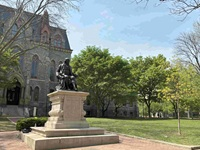Speaker
Description
The future of high energy physics is dependent on advancements in particle colliders, with lepton colliders being one of the more promising avenues. The FCC-ee is one of these options, providing higher luminosities at Higgs mass or top quark anti-top quark production threshold. However, one of the key challenges in FCC-ee detector design is reducing material budget causing adverse effects and improving tracking resolution, particularly in the vertex and tracking detectors. Compared to the current wire chamber standard, gold-coated tungsten, carbon fiber has significantly fewer protons, i.e. Z=6, resulting in a lower radiation length while maintaining thermal mechanical performance requirements. A lower radiation length is expected to improve performance of such a device due to the lower amount of material in the active sensing volume. This work details the initial prototype results, as well as early simulation results for the development of a carbon fiber wire chamber.

